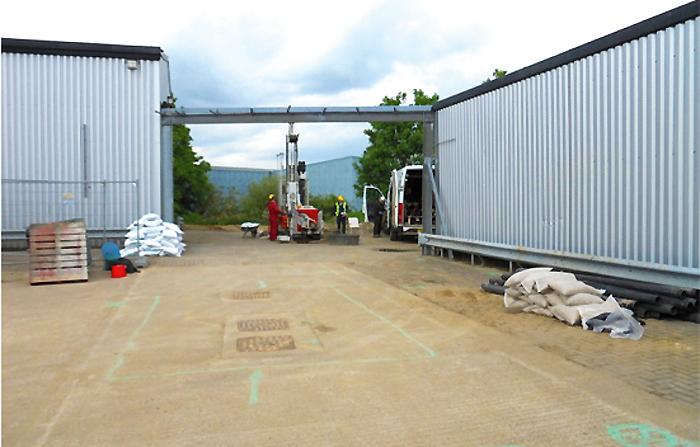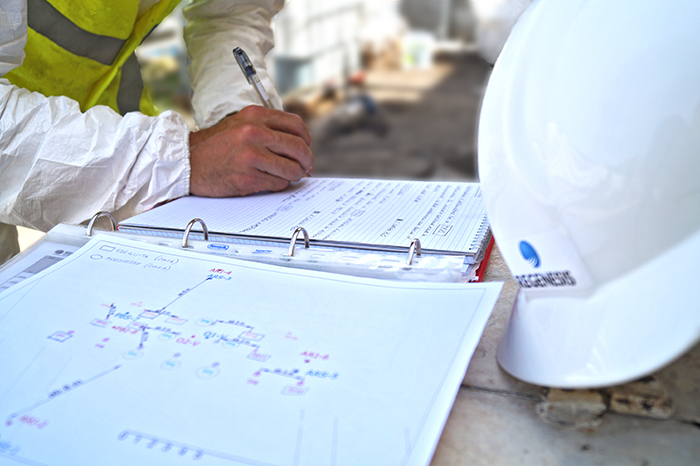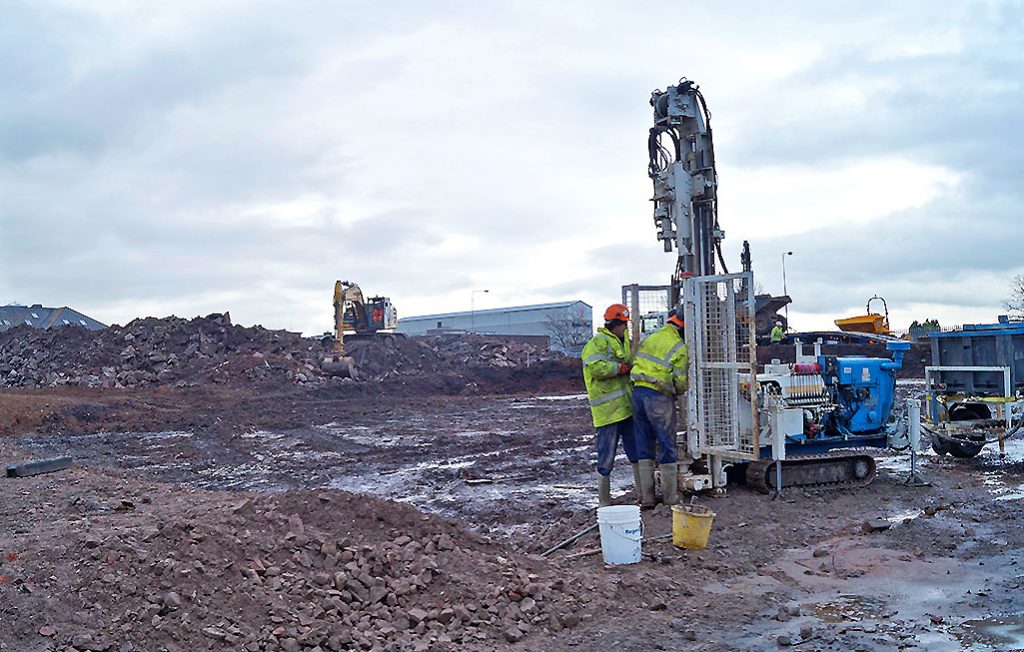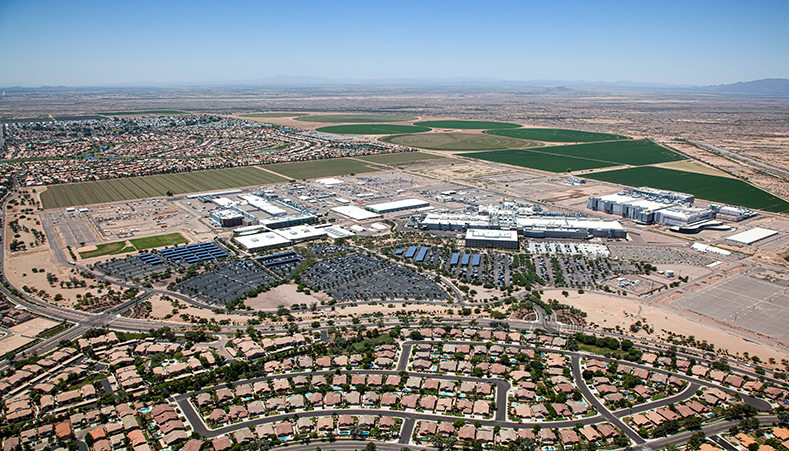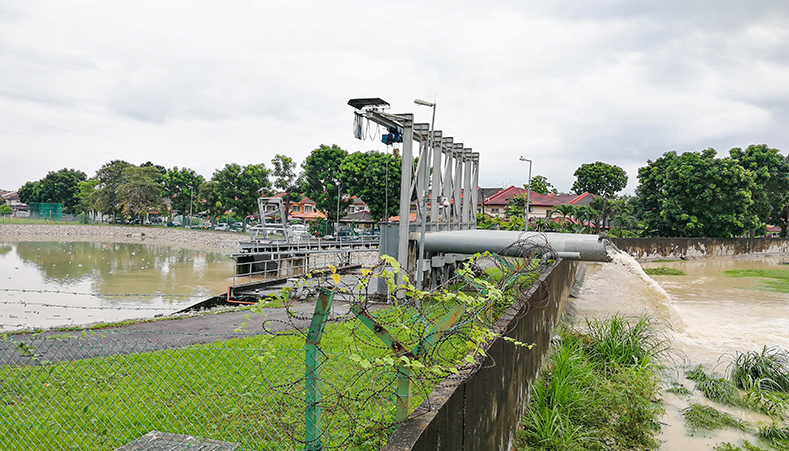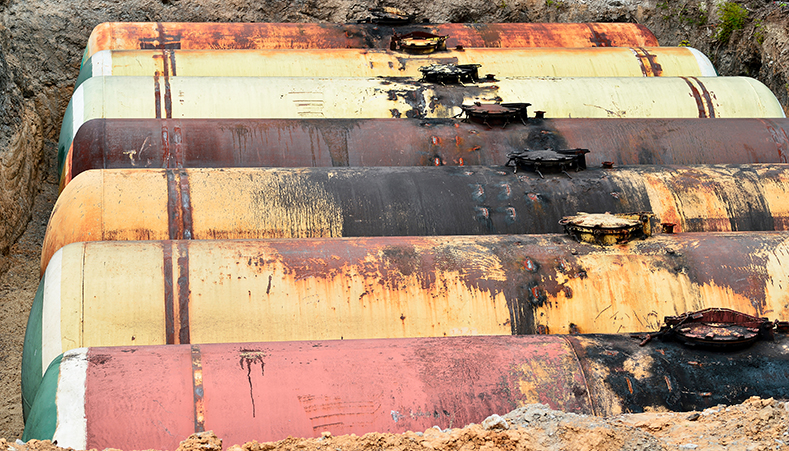In Situ Treatment of 1,2 Dichloroethane Under a Factory, Kent, UK
A single application reduces recalcitrant contaminant below targetRead More
MBTE Remediation at an Active Petrol Filling Station in Italy
Combination of injection activities with targeted groundwater abstraction resulted in successful treatment of non-accessible source areas Read More
Hotspot Treatment of Petroleum Hydrocarbons – North West, UK
Phased, in situ treatment with PetroCleanze and ORC-A Socks allows main contractor to keep programme on trackRead More
Treating Aniline Compounds at a Former Pharmaceutical Plant

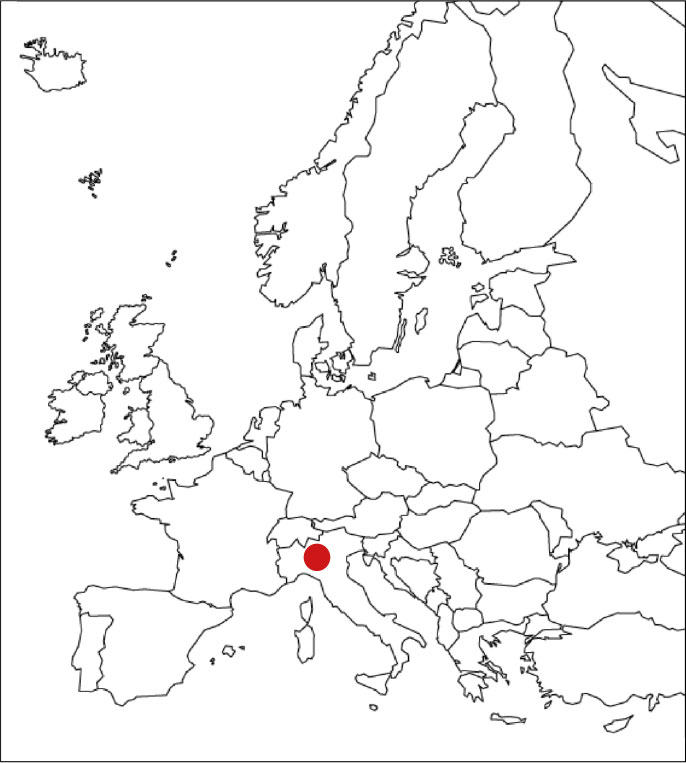
Introduction
The soil and groundwater under a disused pharmaceutical plant in the North of Italy had become impacted with a mixture of aniline and its derivatives, due to historic spillages and leaks on the site. The contaminated unsaturated soil had been removed previously by excavation and disposal (approx. 1,000-1,500 m2) to a depth of 5 m BGL. However, some contamination had infiltrated through the vadose zone and impacted the groundwater, resulting in a 100-meter long plume. In the source area, residual contamination adsorbed to the saturated soil had been detected at 6-9 m BGL; below the maximum depth of the excavation previously completed. It was observed that during periods of high precipitation, the groundwater level would rise and promote recurrent desorption events from this contaminant mass into the groundwater.
Copernico S.r.l was engaged to delineate the contamination through additional site investigation using Membrane Interface Probe (MIP). They found that the main contaminant of concern (COC) was N,N-diethylaniline, which was present at concentrations of approx. 100 mg/kg in saturated soil in the source area, and up to 1,000 μg/L in groundwater across the whole of the site.

Fig. 1 Installation of injection points
Remediation Strategy
A laboratory study previously performed on material and contaminants from this site had shown that aniline was biodegradable under aerobic conditions (especially N,N-diethylaniline). Following this, a biosparge pilot scale study was completed, which proved unsuccessful at dealing with the high concentrations and contaminant loading in the source area. Copernico therefore determined that an integrated remediation approach would be required; initially using ISCO to rapidly address the higher concentrations and then enhanced biological degradation to treat the residual dissolved phase contamination.
It was determined that a persulphate-based ISCO agent was to be applied in two injection campaigns to treat the high levels of adsorbed contamination. After this, the biosparging system would then be operated both in the source and in the plume area. At the downstream boundary of the site, an ongoing pump & treat (P&T) system was used to provide hydraulic containment of the plume within the property, in line with regulatory requirements.
For the ISCO phase, Copernico selected PersulfOx®, a sodium persulfate oxidant with a patented catalyst already mixed into the product. Therefore, no hazardous activation products are required, making the treatment process much safer. The application volume is therefore also reduced, providing cost and time savings to the project.
PersulfOx promotes rapid and sustained ISCO of a wide range of organic oxidants including aniline, through both alkaline activation and surface mediated oxidation on the catalytic surface. This makes the treatment more efficient and effective compared to traditionally based persulfate based ISCO.
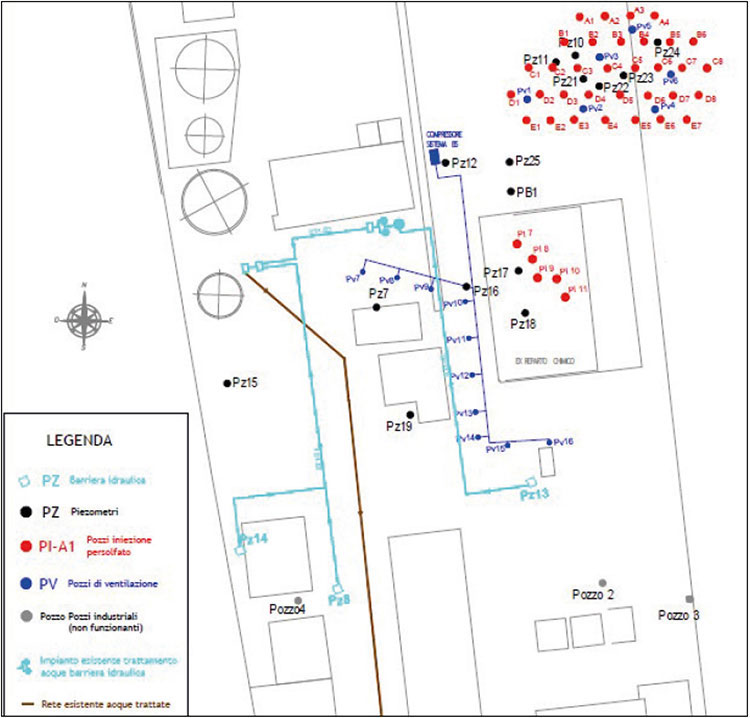
Fig.2 Map showing the PersulfOx injection points (red), Biosparging wells (blue), P&T system (light blue), monitoring wells (dark)
PersulfOx Injection Works
Within the target area 33 injection points (A1-E7), were installed within the vicinity of monitoring wells Pz11, Pz17, Pz18, Pz22, Pz23 and Pz24 (Fig.2).
7,000 kg of PersulfOx was mixed with water to a 15-20% dilution prior to injection into the source area. PersulfOx is simply added to water and agitated, with no requirement for hazardous activation chemicals (such as caustic soda or hydrogen peroxide), making the process much safer, quicker and requiring a lower injection volume (see fig. 3 and 4).
PersulfOx was applied into the injection wells between 6 and 9 m BGL.
A special well completion was used that allowed the application to be completed in 500 mm vertical intervals, in order to ensure an even vertical distribution of the PersulfOx application (fig. 5 and 6). A dose of 25 kg PersulfOx to 175 L of water was applied within each section at approximately 5 Bar or less. A manifold system was used that allowed application into several wells at once in order to make the injection more efficient. The works were completed in 20 days.
Following the initial ISCO application to reduce the contaminant loading in the soils and groundwater in the source area, the biosparge system was operated to provide enhanced natural attenuation of the residual dissolved phase contamination. The biosparge system consisted of 5 ventilation points in the secondary source area, and a second line of 10 points in the plume area; all ventilation points are 15 meters deep.
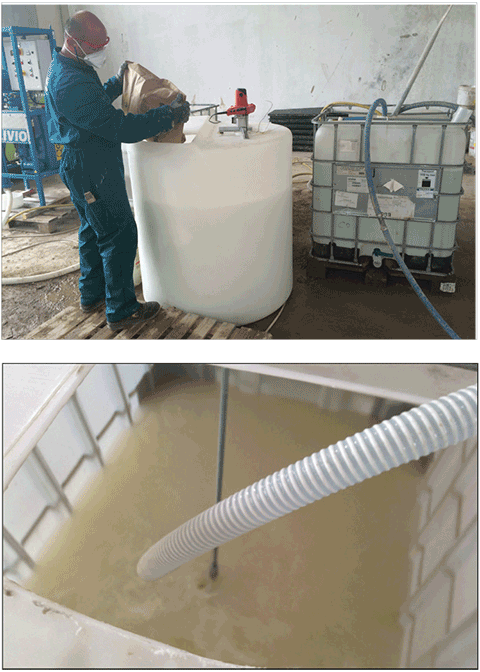
Fig.3 and 4 Mixing activities

Fig. 5 and 6 Injection setup and multi-valve injection points
Results
The first PersulfOx injection campaign was carried out during the months of May and June 2014. Monitoring results from October 2014 show significant, rapid and sustained reduction in all of the Contaminants of Concern (COCs) and remedial targets have been achieved for;
- Aniline (12 out of 12 wells in treatment area)
- N,N-diethylaniline (10 out of 12 wells in the treatment area)
- N-ethylaniline (11 out of 12 wells in treatment area)
The efficacy of the remediation has been monitored through a network of 20 monitoring wells across the site (20,000 m2). Periodical monitoring campaigns have been carried out, including chemical-physical field parameters and laboratory analysis.
Immediately following injection, a temporary increase in the groundwater concentrations of the aniline(s) was observed. This was due to desorption of part of the soil contamination due to the disturbance of the injection and the effect of the ISCO treatment. Once the contamination was in the groundwater, it was rapidly oxidised and the concentrations were then seen to reduce rapidly.
An example of this is well Pz11 (located in one of the most highly impacted areas (7,000 μg/L)), see Figure 7, producing a significant contaminant mass reduction of the whole system (sorbed and aqueaous phase), with a 99% reduction in dissolved phase concentrations by October 2014.
ISCO using PersulfOx not only provided contaminant mass reduction from both the soils and groundwater. Partial chemical oxidation of the COCs resulted in the contaminants becoming more bioavailable and biodegradable. This increased the efficacy of the biosparging system on the residual dissolved phase contamination.
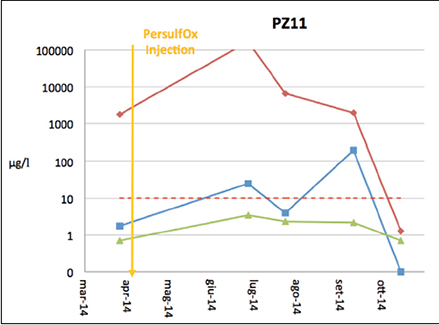
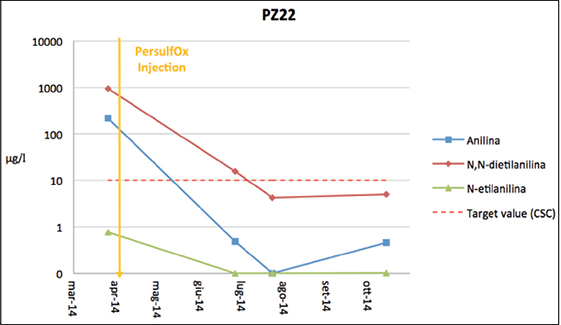
Fig. 7 Total COC concentrations decreased below the target values in Pz11 and Pz22 (Shallow portion of the aquifer) with the use of PersulfOx in 6 months after application.
In the PersulfOx treatment area, all monitoring wells met the target goals within six months for all COCs except for two deep wells (Pz10 and PB1) that still show concentrations marginally higher than target. It is thought that these wells represent areas with higher contaminant mass than was anticipated. Subject to further groundwater monitoring results, a second PersulfOx application may be completed at the site, targeting the recalcitrant wells, as foreseen in the remediation plan. This treatment will be smaller than the first, accurately targeting source areas with higher total contaminant mass.
Biosparging will then be continued in these areas to enhance the biological degradation of the residual dissolved phase contamination. Downgradient of the biosparging system a significant decrease in groundwater aniline concentration has been observed reducing from 1,000 μg/L to <0.1 μg/L. After the remediation activities, aniline concentrations have not exceeded targets (10 μg/L) at the boundary pumping wells, despite periods of heavy rainfall. The remediation resulted in a significant reduction of contaminant mass across the treatment area for all COCs and the residual concentrations are expected to decline further over time.
Conclusions
An intelligent, staged approach was used to complete the site investigation and development of an integrated remediation strategy for the site. This comprised accurate contaminant delineation using Membrane Interface Probe (M.I.P.), evaluation of potential remedial strategy and verification of localised geological and geochemical conditions across the site. This resulted in an accurate in situ remedial design, integrating rapid mass reduction of the COCs
and enhanced biological degradation of the residual dissolved phase contamination.
The treatment successfully reduced COC concentrations to below target goals in the majority of the treatment area and continued to reduce the contaminant levels throughout the validation period.
This site is an excellent example of how good site investigation and an integrated treatment design strategy can provide cost effective and assured remediation of problematic contaminants.
About the Product
PersulfOx is an advanced in situ chemical oxidation (ISCO) reagent rapidly destroys a wide range of contaminants such as petroleum hydrocarbons and chlorinated solvents through abiotic chemical oxidation reactions.
It is an all-in-one product with a built-in catalyst which activates the sodium persulfate component and generates contaminant-destroying free radicals without the costly and potentially hazardous addition of a separate activator. The patented catalyst enhances the oxidative destruction of both petroleum hydrocarbons and chlorinated contaminants in the subsurface.
Benefits
- Promotes rapid and sustained in situ oxidation of a wide range of organic contaminants
- Contains a built-in catalyst that remains active through the entire lifespan of the persulfate oxidation reaction
- The catalyst also eliminates the need for the co-application of alternate and potentially hazardous activation chemistries
- Contaminant oxidation performance equivalent to best alternative persulfate activation methods
- Fewer health and safety concerns than with use of traditional activation methods such as heat, chelated metals, hydrogen peroxide or base
- Single component product results in simplified logistics and application
- No additional containers or multi-step mixing ratios required prior to application
- Compatible with combined remedy approaches including enhanced
biodegradation
PersulfOx Intellectual Property
With the purchase and proper use of PersulfOx Catalyzed Persulfate, Regenesis’ customers gain the benefits of the latest advancements in persulfate technology for environmental remediation.
Furthermore, through an arrangement between Regenesis and FMC Corporation, PersulfOx customers are free to use PersulfOx without any risk of patent infringement claims from FMC Corporation.
AZ Superfund Site Uses ISCO to Replace Recirculation Wells Leading to Cost Savings of $100,000
Project Highlights
- 95% reduction of BTEX, MTBE and TMBs reported on-site
- Total savings estimated to be $100,000
- In Situ Chemical Oxidation (ISCO) combined remedy design incorporates PersulfOx® to effectively address reduction in contaminants
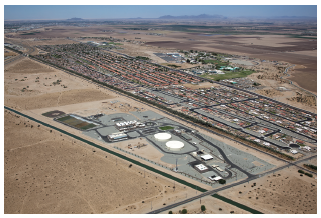
Project Summary
A former industrial paint facility in Tempe, Arizona was contaminated with high levels of gasoline in the groundwater. Ongoing active remediation using Accelerated Remediation Technology (ART) was applied to treat high levels of BTEX, MTBE and TMB. However, this remediation approach was unsuccessful in reducing contaminants to cleanup target levels due to the limited radius of influence produced by the recirculation well system. REGENESIS was approached to design an ISCO plan using the existing treatment well infrastructure.
Remediation Approach
REGENESIS injected 10,028 pounds of PersulfOx at a 12% solution in two applications. As a result, a 95% reduction of BTEX, MTBE, and TMBs was reported post-application. The overall PersulfOx ISCO injection treatment totaled $40,000 – a small fraction of the previously deployed ART system cost and equal to four months of the ART system’s operational expense.
REGENESIS Solutions Applied
PersulfOx is a sodium persulfate-based chemical oxidation technology which destroys both hydrocarbon and chlorinated solvent-type contaminants in the subsurface. PersulfOx contains a built-in catalyst which activates the persulfate component and generates contaminant-destroying free radicals without the need for the addition of a separate activator.
Results
The REGENESIS ISCO plan using PersulfOx contributed to the 95% reduction in BTEX, MTBE, and TMBs while providing significant cost savings to the client in the remediation of this Arizona Superfund site. Use of a combined remedy approach offers clients viable options for achieving cleanup target levels and compressed time to closure.
High TPH Concentrations Treated Using PersulfOx® and ORC® Advanced
Future Site of Stormwater Retention Ponds Remediated with ISCO, Enhanced Aerobic Biodegradation
Project Highlights
- Initial treatment with aerobic bioremediation effectively removed 60% of site contamination.
- PersulfOx® and ORC® Advanced were used to treat two remaining hot spot areas.
- Site closure is pending additional groundwater monitoring.
- Contamination concentrations must be reduced to meet stringent groundwater quality standards.

Project Summary
This site is a former commercial facility in the Southeast with high TRPH contaminant impacts to soils and groundwater. The property is currently vacant and the state department of transportation plans to create a stormwater retention pond on site. However, contaminant concentrations in groundwater need to be reduced to meet stringent groundwater quality standards before any construction can begin.
The plume was first treated via enhanced aerobic bioremediation with ORC Advanced, which effectively removed over 60% of the dissolved-phase contamination within 18 months. In two hot spot areas, residual contamination in the smear zone continued to cause impacts to groundwater. A follow-up treatment combining in situ chemical oxidation and enhacned aerobic bioremediation was employed. PersulfOx and ORC Advanced were used to bring this site towards closure by effectively treating these two hot spot areas. Initial sampling results 30 days after treatment showed attainment of groundwater quality standards.
Remediation Approach
ORC Advanced was injected over 60 direct-push locations across two plume areas. A year and a half post-application, two remaining hot spot areas with residual capillary fringe contamination had caused continued issues. PersulfOx and ORC Advanced were used to bring this site towards closure by effectively treating these two hot spot areas.
Technology Description
ORC Advanced is a proprietary formulation of food-grade, calcium oxy-hydroxide that produces a controlled-release of molecular oxygen for periods of up to 12 months upon hydration.
PersulfOx is a sodium persulfate-based chemical oxidation technology which destroys both hydrocarbon and chlorinated solvent-type contaminants in the subsurface. PersulfOx contains a built-in catalyst which activates the persulfate component and generates contaminant-destroying free radicals without the need for the addition of a separate activator.
RegenOx® Excavation Application Treats Groundwater Contamination
80% TPH Concentration Reduction at California DoD Facility
Project Highlights
- Source removal and RegenOx® ISCO application reduce contamination levels to clean-up standards
- Horizontal piping network installed as contingency plan for additional remediation
- 80% reduction in groundwater concentrations observed

Project Summary
The project site is a former Department of Defense (DoD) fuel dispenser facility in Northern California where past corrective measures included AST/UST removal, soils excavation and groundwater monitoring. Sample results indicated continued elevated concentration levels of TPH-G, TPH-D and TPH-mo within a defined area near the former USTs. The treatment approach included additional excavation and in situ chemical oxidation (ISCO) application via RegenOx mixed into saturated zone. Quarterly sampling indicated an 80% reduction in groundwater concentration levels post treatment; which met the corrective action cleanup levels for TPH.
Remediation Approach
The selected contractor excavated, managed and disposed of impacted soils to depths of nine feet over the two defined treatment areas. RegenOx Part A (oxidizer) and Part B (silica gel activator solution) were placed in the saturated zone and mixed in with the excavator bucket to 3 feet below the excavation bottom. Prior to backfill and compaction, a horizontal piping network was installed to serve as a contingency plan in the event that any additional in situ and/or bioremediation remediation was required. Regenesis assisted the client with the horizontal piping network design which was incorporated into the bid specifications. This site area has been submitted for closure and with continued quarterly monitoring.
Technology Description
RegenOx is an advanced chemical oxidation technology that destroys contaminants through powerful, yet controlled chemical reactions and not through biological means. This product maximizes in situ performance while using a solid alkaline oxidant that employs a sodium percarbonate complex with a multi-part catalytic formula.
Acetone and Petroleum Hydrocarbons Treated at Active Industrial Facility
Combined ISCO/Bioremediation Treatment Approach Reduces Contamination Levels
Project Highlights
- Acetone concentrations pre-remedation were as high as 54,000 μg/L
- Site access agreement required that existing site operations could not be interrupted for construction
- Site water was not allowed to be used therefore all water had to be trucked in and a separate water permit to access city water from fire hydrants was required
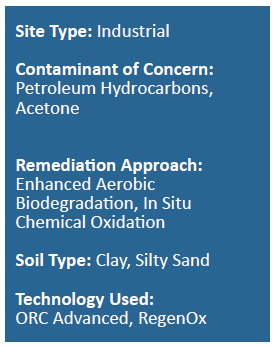
Project Summary
A former industrial facility in northern California operated as a gas manufacturing plant from the early 1900s until it was decommissioned in 2001 and sold. The property is currently leased by a bottled water distribution facility.
At this facility, acetone was used extensively in acetylene manufacturing. The acetone was stored on-site in underground storage tanks (UST) but no evidence of leaking acetone USTs was found.
However, high concentrations of acetone – a pre-remediation maximum of 54,000 micrograms per liter (μg/L) were found in one area of the site. Other dissolved chemicals of concern (COC) include gasoline and gasoline-range petroleum hydrocarbons from former USTs such as benzene, toluene, ethylbenzene and xylenes (BTEX).
The extent of contamination in the early 1990s extended to large portions of the site. A pump and treat system was used on-site in 2005, however contamination persisted. Contamination approximately 12 feet below ground surface was detected within the soil. A remediation plan using both ORC® Advanced and RegenOx® was used to treat the remaining contamination.
The site access agreement for this project required that existing site operations could not be interrupted for construction. In order to minimize disturbance to tenants and work within these constraints, all drilling field work was performed on weekends. Site water was not allowed to be used therefore all water had to be trucked in and a separate water permit to access city water from fire hydrants was required. In addition, multiple drill rigs and support vehicles operated within a small area, increasing logistical and safety concerns.
Remediation Approach
A mixture of 6,500 pounds of RegenOx and 3,000 pounds of ORC Advanced was injected at 45 locations using multiple direct-push drill rigs. The injection points were designed in a grid pattern with a nominal 15-foot spacing between injection points, but more densely placed in the area of highest contaminant concentration. Benzene concentrations in groundwater have stabilized at about 10 μg/L and acetone concentrations have stabilized at about 1,600 μg/L. Post-treatment monitoring results show that all the COCs in the treatment area have consistently remained below health-based cleanup levels since the treatment was applied.
Technology Description
Advanced Formula Oxygen Release Compound (ORC Advanced®) is a proprietary formulation of food-grade, calcium oxy-hydroxide that produces a controlled-release of molecular oxygen for periods of up to 12 months upon hydration.
RegenOx is an advanced chemical oxidation technology that destroys contaminants through powerful, yet controlled chemical reactions and not through biological means. This product maximizes in situ performance while using a solid alkaline oxidant that employs a sodium percarbonate complex with a multi-part catalytic formula.
Open Excavation Treatment at Former NJ Service Station
RegenOx® and ORC® Advanced Pellets Remediate Petroleum Hydrocarbon Contamination
Project Highlights
- Former service station contaminated with BTEX levels measuring 11 ppm in groundwater and soil impacts removed through excavation
- Combined remedy to treat the open excavation with both in situ chemical oxidation and enhanced aerobic bioremediation technologies
- RegenOx and ORC Advanced Pellets technologies are compatible/non-corrosive with underground infrastructure and utilities infrastructure in the subsurface

Project Summary
A former service station in New Jersey was contaminated with high levels of BTEX (measuring 11 ppm in groundwater pre-treatment). Due to significant amounts of contaminated soil mass remaining at the former service station, an excavation was proposed by the environmental consultant. RegenOx and ORC Advanced Pellets were applied to the open excavation to chemically oxidize remaining saturated impacts and to promote enhanced aerobic biodegradation of petroleum hydrocarbons in the dissolved phase. Both of these technologies utilize alkaline chemistry (pH > 8), which is non-corrosive to nearby public utilities and the underground infrastructure at the service station.
Remediation Approach
RegenOx and ORC Advanced were co-applied into an open excavation at the former service station site. The excavation extended approximately four feet into the saturated zone. Because the excavation was limited by physical constraints, RegenOx, a chemical oxidant, was applied to the base of the excavation to oxidize and desorb residual petroleum mass from the soil. ORC Advanced Pellets were co-applied to provide a slow release of oxygen (up to 12 months longevity) that promotes enhanced aerobic biodegradation of petroleum hydrocarbons. In total, 2,000 pounds of RegenOx and 882 pounds of ORC Advanced Pellets were co-applied to the 2,600 square foot excavation area.
Technology Description
The advanced formulation of the Oxygen Release Compound (ORC Advanced) is a proprietary formulation of food-grade, calcium oxy-hydroxide that produces a controlled-release of molecular oxygen for periods of up to 12 months upon hydration. The pelletized form of ORC Advanced were designed to improve safety and handling for excavation applications.
RegenOx is an advanced chemical oxidation technology that destroys contaminants through powerful, yet controlled direct oxidation and free-radical reactions. This product maximizes in situ performance through the use of a solid alkaline oxidant (a sodium percarbonate complex) and a multi-part catalyst. These oxidation reactions do not inhibit natural bacterial populations and are compatible with biological treatment methods.
Combined Remedies Treat BTEX Contamination on Government Property
Ontario, Canada Site Remediated with ORC® Advanced and RegenOx®
Project Highlights
- In Situ Chemical Oxidation (ISCO) and Enhanced Biodegradation used post-excavation to treat residual contamination.
- Extensive site mapping conducted with membrane interface probe (MIP) to detect distinct zones of higher mass contamination.
- 95% reductions seen in dissolved phase petroleum hydrocarbon contamination.
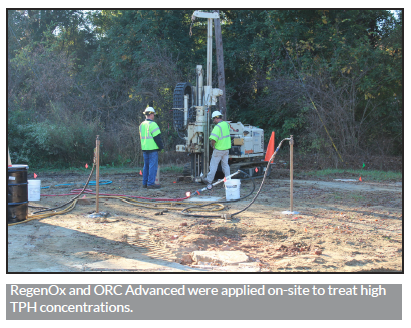
Project Summary
A large public works property in Ontario, Canada was contaminated with TPH. Approximately 5,000 gallons of fuel was released into the subsurface primarily due to fuel theft that had taken place on-site. Due to significant volumes of free-product, an excavation occurred followed by skimming activities from 2005-2010. Through extensive site evaluation, it was determined that there was a need for further mass reduction using ISCO.. RegenOx® ISCO was selected for use in the heavily and moderately impacted areas. Enhanced aerobic biodegradation using ORC® Advanced was selected for use in the dissolved-phase areas downgradient from the source. Overall, 96% reductions were seen in dissolved phase petroleum hydrocarbon concentrations.
Remediation Approach
Membrane interface probe (MIP) data was collected and proved to be integral for the remediation design and implementation. Distinct zones with high mass were present on-site and detected through the probe. RegenOx and ORC Advanced were applied via direct-push injections. Approximately 150,000 pounds of RegenOx and 45,000 pounds of ORC Advanced were applied over several injections. Higher concentrations of RegenOx were applied into the vertical zones of higher contamination to improve overall product performance.
Technology Description
Advanced Formula Oxygen Release Compound is a proprietary formulation of food-grade, calcium oxy-hydroxide that produces a controlled-release of molecular oxygen for periods of up to 12 months upon hydration.
RegenOx is an advanced chemical oxidation technology that destroys contaminants through powerful, yet controlled chemical reactions and not through biological means. This product maximizes in situ performance while using a solid alkaline oxidant that employs a sodium percarbonate complex with a multi-part catalytic formula.

 Americas
Americas Europe
Europe Français
Français Deutsch
Deutsch Italiano
Italiano Español
Español